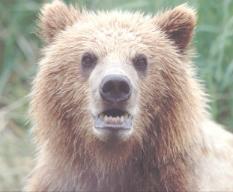 Each spring black bears emerge from their dens hungry and with little available sources of food. During this time, as young conifers approach their annual spring bud burst, there is a high concentration of sapwood moving up the tree just inside the bark. This sapwood is rich in carbohydrates and can be a very attractive food source for hungry bears. The bears rip off the bark to eat the sapwood and in the process they often girdle and kill the trees. Bears can girdle up to 50-70 trees a day, and this loss can create a significant economic impact for forest landowners. By late June or early July there are plenty of natural foods for bears to eat, and generally damage to the young timber ends about this time.
Each spring black bears emerge from their dens hungry and with little available sources of food. During this time, as young conifers approach their annual spring bud burst, there is a high concentration of sapwood moving up the tree just inside the bark. This sapwood is rich in carbohydrates and can be a very attractive food source for hungry bears. The bears rip off the bark to eat the sapwood and in the process they often girdle and kill the trees. Bears can girdle up to 50-70 trees a day, and this loss can create a significant economic impact for forest landowners. By late June or early July there are plenty of natural foods for bears to eat, and generally damage to the young timber ends about this time.Last month I attended a presentation by Georg Ziegltrum of the Washington Forest Protection Association (WFPA) at the Department of Natural Resources monthly breakfast meeting. Georg’s presentation was primarily about WFPA’s Black Bear Supplemental Bear Feeding Program, although he also talked about other components of the WFPA’s Animal Damage Control Program, including lethal control efforts.
 In 1985 WFPA began the Black Bear Supplemental Feeding Program. In 2006, the Program used a total of 465,700 pounds of bear pellets at 860 feeding stations in Western Washington in an effort to reduce spring black bear damage to young private timberlands. The Black Bear Supplemental Feeding Program feeds black bears at special feeding stations for about 2 ½ months each year to provide a food source during the spring when food sources are limited. Young even-aged stands between 15 and 30 years of age are the most vulnerable to bear damage, and the supplemental feeding program has helped to reduce this damage.
In 1985 WFPA began the Black Bear Supplemental Feeding Program. In 2006, the Program used a total of 465,700 pounds of bear pellets at 860 feeding stations in Western Washington in an effort to reduce spring black bear damage to young private timberlands. The Black Bear Supplemental Feeding Program feeds black bears at special feeding stations for about 2 ½ months each year to provide a food source during the spring when food sources are limited. Young even-aged stands between 15 and 30 years of age are the most vulnerable to bear damage, and the supplemental feeding program has helped to reduce this damage. However the Black Bear Supplemental Feeding Program does not prevent all damage to young timber stands. This program is used along with lethal control, in areas with heavy damage, to limit impacts to private forestlands. In 2006, Washington Department of Fish and Wildlife (WDFW), in cooperation with WFPA’s Animal Damage Control Program, issued about 190 depredation permits for black bears in areas where there was heavy timber damage on private forestland. Most of the bears are removed by hound hunters, although foot snares and bait are also occasionally used with depredation permits.
Website links of interest:
Washington Forest Protection Association’s (WFPA) Animal Damage Control Program 2006 Annual Report
A 2-page summary of the Black Bear Supplemental Feeding Program
Efficacy of the Black Bear Supplemental Feeding Program in Western WA
Nan Laney
Skagit and Whatcom Coordinator, GBOP
